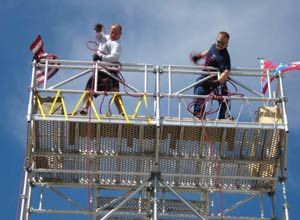| Editor’s note: ‘Getting Ready for the Challenge’ is a series by Michael Medeiros on what you can do to prepare for the Firefighter Combat Challenge or for the individual components of the event that can be found in annual physical performance assessment testing. |
 Photo Michael Medeiros |
| Related Article: Get Ready for the Challenge |
During the first part of this series we discussed the application of leg endurance for the tower ascent and descent. The next step to this process will be getting the upper body strength and muscle reaction needed to get through the challenge in a timely manner, both safely and accurately.
The upper body endurance and strength is as important as leg endurance. As the body shunts oxygenated blood to the legs during the first part of the challenge or ability test, you find your upper body lacking the pump it needs to perform the pulling and striking at that high rate of speed.
Rope pull & forcible entry
You need to find the energy to complete these two tasks even when the oxygen in the upper body is depleting and the lactic acid is building. Pulling a rope attached to a section of rolled hose up four to five stories takes arm, shoulder and back strength.
- You must keep the core of the body tight
- Try to reach as low on the rope as possible and take long pulls with full extensions
- As you reach with one hand, the other hand should be dumping off the excess
- Do not allow the rope to stop, always move your hand down the rope while you keep moving the loose stuff away
- Place the excess rope behind you so as to keep it from entangling with the extended section
- Always keep the rolled hose moving upward without allowing it to bounce or drop back down
- Grab as low to the carabineer when bringing it over
The striking or chopping motion of the vertical ventilation task (also called the Keiser sled) uses most of the upper body strengths with the lower body stabilizing and balancing.
- Always stand in front of the beam
- Use the chopping method between your legs
- Solid blows, centered on the beam, neither too high nor too low
- Short or long chops will depend on each individuals body structure
- Try to keep the beam moving, not allowing it to stop until your done
- Breath normally, avoid holding your breath during your hits
- When connecting with the beam, you should at that time have the tightest grip of the hammer. This will help in the delivery of energy from you to the beam
Rope pull and Keiser preparation
As mentioned previously, you should always train to the specific task. The functional movements for rope pulling and Keiser force machine chopping utilize most of the shoulders. Using training methods that strengthen the shoulders, scapula, trap, and your arms will help keep you from possible injury.
1. The program should start a few months out from testing or competition with body weight exercises such as pull-ups, pushups, burpees, hand stand pushups and the plank. Then you can move into actual power lifting programs. Maxing out your reps when getting closer to the endurance portion of training will always increase your muscular strength and endurance. Some of the lifts that will help with this challenge are:
• Power Cleans
• Squats
• Overhead Press
• Clean & Jerk
• High Pulls
Place these lifts into an interval program starting with low reps at the beginning
2. About a month out from competition or testing, you need to pull rope and strike the Keiser two to three times a week. Try to concentrate on long pulls and work up to technique. You can also pull a heavier load, then a lighter load twice, and then finish with the regular weight. As for the Keiser, you need to hit the beam until it reaches the end then turn and hit it back. Clean off the skids and repeat. Remember to still have your lifting days set in between your course days.
3. A couple of weeks out, you should work on speed and endurance by doing the tower and Keiser drill. In part 1 we discussed the tower ascent and descent, use that drill and include the rope pull and Keiser. Start with the ascent, then pull rope, descend down to the Keiser sled, hit the sled until it is done. Have someone reset behind you so that you can repeat this drill within 30 seconds. Try for three sets in a row. Always mark down all your times so that you can trend your speed.
A great program is only as good as the amount of work put into it. Some things that work for others may not work for you. So adapt your program to your specific needs and goals. Always remember to have rest days so you can allow the body to recover. Only you will know how many days you can go without a rest day.
At the end of every workout session you need to take the time to statically stretch out the muscle groups used that day. Never continue a workout if you experience pain or resistance that causes pain. If you find to have soreness/pain longer than three to four days, you may need to consult your physician.
Read: Part 1











